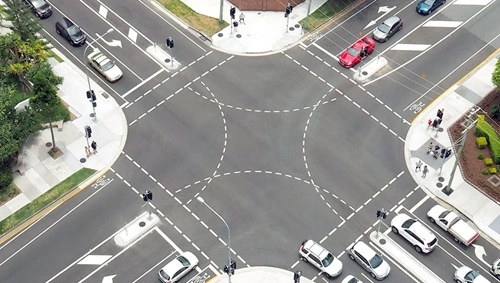This can’t be answered in a simple Yes or No. Why? Well, that’s just because there are some states that make it illegal straight up, but others allow it if you do it more carefully and safely. So yes, this whole lane changing thing in an intersection is a bit complex, and if you want to know more about it, we’ll advise you to check back on the laws or rules that your specific state has for this. Anyway, still, we’ll try our best to explain everything in the simplest way possible. Here we go.
What Counts as a Lane Change in an Intersection?

All the intersection represents is the spot where two or more roads cross. You see traffic lights, stop signs, and crosswalks, which are all ordinary types of things. Now lane change is moving from one lane into another-for example, entering a lane to get ready for turning or passing a slower vehicle.
A lane change in an intersection is dangerous if you are already in an intersection, trying to switch lanes, and vice versa.
Is It Legal? Depends on the State
To be honest, actually, there is no law that governs this nationwide; every state promulgates its own traffic code. A few states, like California and Texas, would forbid a lane change within an intersection. The logic behind this is based on the rationale that intersections are busy enough in cooperation with cars, pedestrians, bicycle movements, and signals; adding lane changing to the work is just increasing the risk.
If we are to contrast, states like Illinois allow it, but with conditions. There are a few conditions: You have to activate your signal, check your mirrors, and see that it is safe to make the move. Law is not just about “can” or “can’t,” but rather the process of “how you do it.”
Road Markings Matter Too
A lane change at an intersection may be permitted by your state, but it is nevertheless advisable to look at the road while doing so. The markings on the road can give helpful hints about whether or not you should proceed.
- Solid white lines exist between lanes? If yes, do not cross. Usually, it is unsafe or there are restrictions on doing so.
- Broken white lines? Well, if that’s the case, then you may be able to make a lane change, but only if doing so is safe.
Observe signs and construction zones as well. If a sign says No Lane Changes, then that takes the highest precedence against everything else, even though the maneuver might be usually allowed in your state.
It Might Not Be Illegal, But It Can Still Get You Pulled Over
Assuming your state doesn’t specify lane changing in an intersection as illegal, you cannot believe that one has got away with a violation. An emergency stop is worth electing over the pull over if the lane change is sudden, unsafe, or forces another driver to respond quickly or even brake hard.
Many states have very clear provisions regarding unsafe lane changes. Thus, if a specific provision does not exist about intersections, the move will still count and fall in the dangerous category of traffic violations.
Why Lane Changes in Intersections Are Risky
Most of the time, you see, intersections are messy. Cars are maneuvering to turn from all directions; pedestrians are walking across; cyclists and motorbikes are partly sharing the road amongst the vehicles; it’s all happening at once. So, sure enough, like, changing lanes here shall reduce your reaction time and increase collision chances.
Other drivers on the road do not expect you to change lanes. A vehicle in your blind spot may go unnoticed. Sudden moves could cause confusion even if nothing went wrong. And that is how small mistakes cause fender-benders.